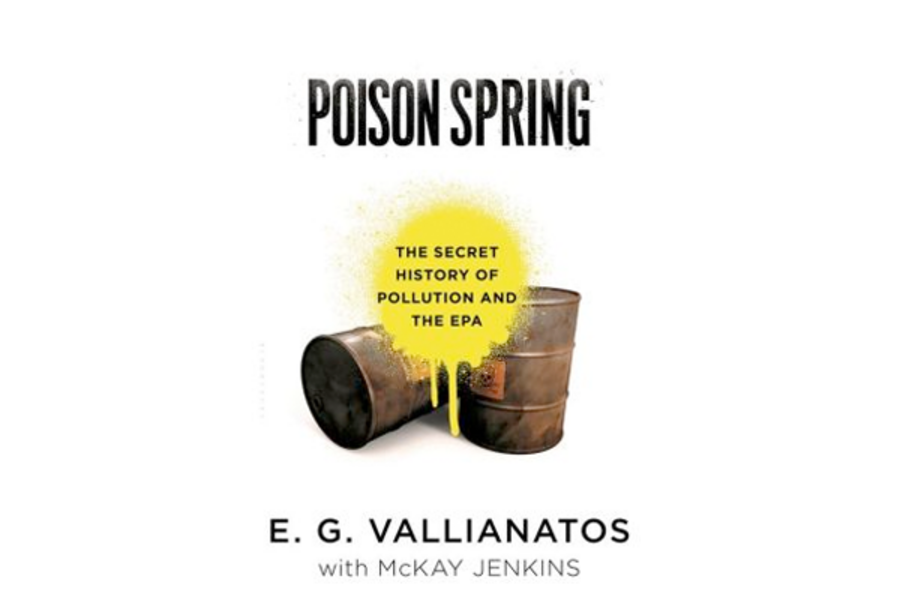Poison Spring
In 1978, eight women from Oregon contacted the Environmental Protection Agency to ask if there was a connection between their recent miscarriages and the spraying of herbicides nearby. These women had all given birth to babies with fatal brain defects and a subsequent study showed that women in the town who lived near a herbicide-sprayed highway were having miscarriages at three times the normal rate. It transpired that the miscarriages were caused by the herbicide, which contained the same chemical used in Agent Orange, the infamous chemical weapon used during the Vietnam War.
This episode is just one of the harrowing anecdotes related in Poison Spring, a book that is disturbing on two levels. On the one hand, it tells the story of a half-century of poisoning of America’s citizens and natural resources. On the other hand, it tells the story of the Environmental Protection Agency’s failure to do anything about that poisoning. The author, E. G. Vallianatos, worked for the EPA for 25 years and witnessed firsthand what he calls the agency’s “poison empire” – the EPA’s collusion with chemical companies to turn a blind eye to the systematic poisoning of America’s food supply, animals, water, and people. Together with science writer McKay Jenkins, Vallianatos presents a disturbing and compelling portrait of how, in the 50 years since Rachel Carson’s "Silent Spring" condemned DDT, poisons have infiltrated our society more than ever.
Vallianatos researched his book through his own experiences at the EPA as well as through numerous documents that he accessed during his time there. What emerges is a scathing portrait of an agency that’s either powerless to affect change and police the environment or that’s actively engaged in covering up the truth about pesticides and other chemicals. Vallianatos says that the agency maintains a “revolving door” policy under which chemical company employees take jobs at the EPA, thus compromising the agency’s mission. At the agency, employees were encouraged to suppress information: once, Vallianatos was chastised for picking a letter highlighting DDT contamination in Texas out of the trash because he was told that the letter would be damning in potential future litigation.
Much of the EPA’s actions are backed up by what Vallianatos calls fraudulent science, where companies pay so-called experts to certify that their chemicals are safe. One example was the grisly Industrial Bio-Test Laboratories, where industry representatives falsified tests of chemicals from the 1950s through 1980s.
Whistle-blowers who have tried to call attention to this phenomenon have historically been punished or silenced. Vallianatos tells the stories of coworkers who challenged the EPA’s lies about the safety of various chemicals, only to find themselves transferred to clerical jobs or saddled with unsatisfactory performance reviews.
The result of all this? Vallianatos describes a world where pesticides and chemicals are everywhere: in exploding Raid Flea cans under household sinks; in our milk; in our drinking water; in honey and on golf courses. These chemicals harm animals and insects that are essential for our food supply and ecosystem, such as honeybees, which are important pollinators. But they also have a horrendous effect on humans. A study in the 1970s showed that migrant workers who come into daily contact with pesticides suffer from a variety of terrible maladies, including skin rashes, tuberculosis, and abnormal kidney and liver functions.
Vallianatos condemns both Democrats and Republicans for allowing this systematic failure on the part of the EPA to protect Americans from these chemicals. His book covers the presidencies of Ronald Reagan and George W. Bush and condemns those administrations for their cozy relationship with chemical companies, but he also accuses the Obama administration of doing the same thing, pointing out that Obama signed an act that protects companies from being sued if their genetically modified seeds lead to health problems.
Vallianatos’s portrait of the EPA is not simply a historical text that covers the past failings of this agency. He emphasizes that these problems are still endemic in American society, pointing out that pesticide drift from industrial farming still affects many parts of the country. And he says that fracking is the latest example of the EPA’s failure to protect the public. This controversial gas drilling process causes toxic liquids to seep into and contaminate groundwater, but the government does nothing about it due to a legal loophole.
Vallianatos ends his book with a call to action: reorganize the EPA to remove the chemical industry’s influence over the agency and turn to traditional small farms to grow our nation’s food supply. And it’s easy to see why that call to action is so important after reading this book. Ultimately, Vallianatos’s narrative is a passionate and disturbing history of an agency that was designed to protect us but that has failed completely.
Emily Cataneo is a Monitor contributor.






